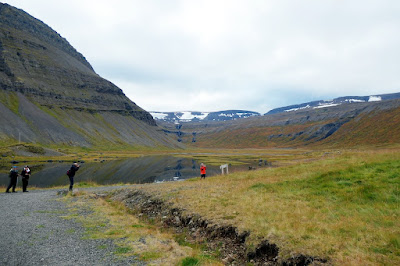On September 18th, 2022, the Endurance approached the northwestern tip of Iceland, known as the Westfjords, and the bay Ísafjarðardjúp. (Click on the images to enlarge.)
Joan and I awoke to the sunrise.Humpback whales favor this area, and as the Endurance slipped into the bay, we all scanned for whale spouts.
There they blow!Often we saw pairs, mom and calf.The pectoral fins can be close to the surface as the cetaceans cruise and feed.
The patterns on the underside of the tail are unique fingerprints used to identify individual whales.After our whale-watching time expired, an Icelandic pilot came aboard the Endurance to guide us into the harbor at Ísafjörður.Centimeter by centimeter, we edged up to the dock.Lindblad offered four options for today's activity: 1) a bus tour of the terrain and exploring the town of Flateyri, 2) a hike in the Valagil canyon, with a destination waterfall, plus the village of Súðavik, 3) a walking tour of Ísafjörður, or 4) a bicycle tour on a road that climbs 359 meters (1,177 feet) and is closed to vehicles because of avalanches and rock slides. Joan and I had covered some of these Westfjords during our 2019 land-based tour of Iceland, documented in this blog here and also here, so it was easy for us to choose option #2.
Joan and I awoke to the sunrise.Humpback whales favor this area, and as the Endurance slipped into the bay, we all scanned for whale spouts.
There they blow!Often we saw pairs, mom and calf.The pectoral fins can be close to the surface as the cetaceans cruise and feed.
The patterns on the underside of the tail are unique fingerprints used to identify individual whales.After our whale-watching time expired, an Icelandic pilot came aboard the Endurance to guide us into the harbor at Ísafjörður.Centimeter by centimeter, we edged up to the dock.Lindblad offered four options for today's activity: 1) a bus tour of the terrain and exploring the town of Flateyri, 2) a hike in the Valagil canyon, with a destination waterfall, plus the village of Súðavik, 3) a walking tour of Ísafjörður, or 4) a bicycle tour on a road that climbs 359 meters (1,177 feet) and is closed to vehicles because of avalanches and rock slides. Joan and I had covered some of these Westfjords during our 2019 land-based tour of Iceland, documented in this blog here and also here, so it was easy for us to choose option #2.
First, we were bussed to the Valagil Canyon and waterfall. Enough of us signed up for option #2 that we needed two buses.
Waterproof footwear was handy as we negotiated the deep canyon route.Further on, the waterfall began to appear.Approaching the lower cascade of this multi-stage waterfall.Looking up, with others on ahead.The rushing water made a steady roar. When Joan and I climbed higher, we could look down on those who chose not to tackle the sketchy slope.
A brief clip of the noise this cascade made ...
Waterproof footwear was handy as we negotiated the deep canyon route.Further on, the waterfall began to appear.Approaching the lower cascade of this multi-stage waterfall.Looking up, with others on ahead.The rushing water made a steady roar. When Joan and I climbed higher, we could look down on those who chose not to tackle the sketchy slope.
A brief clip of the noise this cascade made ...
After our return hike, our bus took the group to the village of Súðavik,
where we visited the Arctic Fox Center. Two foxes were living there, either permanently or for rehab. (Two is the most the center can take.) You can bet they were photogenic.A closer look at the blue, or darker, morph, which is usually found in coastal areas.The other fox, a white morph, was beginning to shift from its summer coat to the white winter coat. White foxes are generally found inland.
The museum itself offers exhibits and videos about the Arctic fox, its physiology, history, and past persecution. Lindblad had also arranged for hot drinks and snacks for our group!
Then, it was time to return to the ship. The kitchen offered a special Filipino buffet for dinner, and then the staff and crew staged a fabulous show for us.
What a variety they presented: songs, traditional dances, drag queens. Half the attendees got up and danced when the band gave a rousing rendition of the Eagles' "Hotel California." It made for a late night as we sailed on towards the island of Flatey.

















































